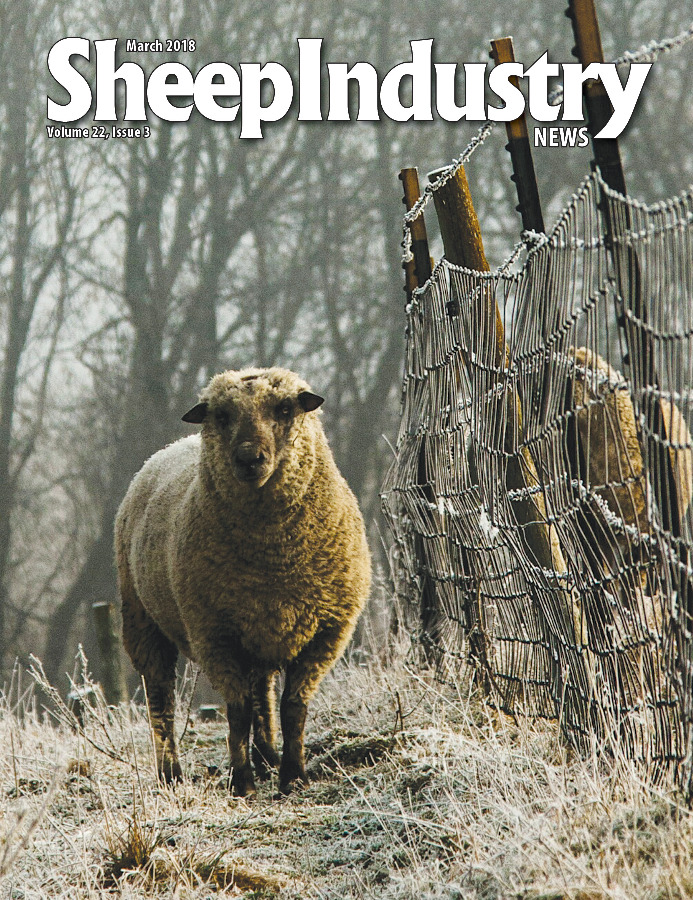
- March 2018
- President’s Notes
- Jerry King Cartoon
- Convention: Sheep Producers Share Concerns with USDA
- Convention: Industry Leaders Recognized
- Convention: MIWW Celebrates 70 Years
- Convention: American Wool Uses Technology
- Convention: Nourish With Lamb Spreads Message
- Convention: PERC Discusses Possible FMD Outbreak
- Convention: Kangols Top Guard Dog Breed
- Convention: Genetic Stakeholders Understand Value of Data
- Convention: Sheep Disease Updates
- Convention: Resource Management Eyes Progress
- Convention: Young Entrepreneurs
- Electronic Grading Approved at Superior Farms
- ALB Picks Denver as Next Target Market
- Wool is Popular at Outdoor Show
- Sheep Inventory Flat in 2017
- Feedlot Report Available
- Young Entrepreneur: Jake Kerr
- Sec. Perdue Names ALB Appointees
- Three Appointed to Sheep Center
- Around the States
- Market Report
- The Last Word
Wildlife Services Study Shows Kangols as Top Guard Dog Breed
CAT URBIGKIT
The Shepherd
While there were several research topics discussed at the annual Production, Education and Research Council meeting in early February in San Antonio, the topic of guard dogs stole the show.
After all, everyone likes a good dog story.
Dr. Julie Young with the U.S. Department of Agriculture’s Wildlife Services provided an update on the final results of the agency’s recent research regarding the effectiveness of various livestock guardian dog breeds. The imported breeds – Transmontano, Kangal, and Karakachan – were compared to the traditional big white dog breeds such as Great Pyrenees, Akbash and Maremma commonly used throughout the Rock Mountain West.
Which guardian dog was best in terms of sheep survival?
The risk to sheep decreased with more Kangals in the flock, versus using BWDs. Young said sheep depredations increase with larger flock sizes, and increasing depredations also occurred with the increasing number of guardian dogs used. She said that the breaking point seemed to be four or five dogs, and suggested that the reason might be that dogs miscommunicate or get bored because there are too many dogs, leading some to wander or do other things.
Which LGD is best for which predator?
Kangals are really good against cougars, black bears and coyotes, Young reported. Although the data indicated that the risk of wolf depredation increased in the presence of Kangals. Young said this result might be an artifact of using traditional statistics to measure something that happens in pulses (such as a major attack on a sheep flock). The Kangals were younger dogs than most of the BWDs, so that could have influenced the research outcome, as well.
Karakachans did better against both Kangals and BWDs in terms of preventing depredations from coyotes.
Transmontanos weren’t included in the research results because the flocks that used Transmontanos didn’t have enough depredation events to have usable data. That means researchers either got lucky with their placement of Transmontanos – with herds that didn’t have much predator pressure – Young said, or those Transmontanos were simply so fantastic that there weren’t any depredations. Unfortunately, researchers did not have enough data to make that determination.
Do LGD breeds behave differently?
Behaviorally, LGDs were more similar than different. Their differences were subtle, with Karakachans being more vigilant, Kangals more investigative and Transmontanos better at assessing threats.
How do carnivores respond to LGDs?
Dogs and sheep together make a defended prey, Young noted. The researchers measured detection rates of predators in the presence of sheep flocks with LGDs.
“Interestingly, wolves leave the area,” she said. Wolves were detected a lot more often before the defended prey arrived in their pastures, when mesopredators (bobcats, red fox, coyotes) were more likely to be detected (the mesopredators release theory). There were no results for bears.
LGDs are effective against wolves, Young said, “but they are probably doing it by displacing the wolves.”
Young said that having LGDs did not seem to mediate tolerance for wolves or grizzlies, according to survey respondents.
In other presentations, Dr. John Walker of Texas AgriLife gave an overview of range and animal science research in Texas, Dr. Larry Clark of Wildlife Services provided an update on livestock protection research, and Dr. Bret Taylor effectively debunked the reasons producers commonly cite for not exposing ewe lambs to rams.
Dr. Brad Freking of the USDA Meat Animal Research Center also provided an update on MARC’s program to evaluate maternal lines under pasture management.

